AI Research
Physicians Lose Cancer Detection Skills After Using Artificial Intelligence

Artificial intelligence shows great promise in helping physicians improve both their diagnostic accuracy of important patient conditions. In the realm of gastroenterology, AI has been shown to help human physicians better detect small polyps (adenomas) during colonoscopy. Although adenomas are not yet cancerous, they are at risk for turning into cancer. Thus, early detection and removal of adenomas during routine colonoscopy can reduce patient risk of developing future colon cancers.
But as physicians become more accustomed to AI assistance, what happens when they no longer have access to AI support? A recent European study has shown that physicians’ skills in detecting adenomas can deteriorate significantly after they become reliant on AI.
The European researchers tracked the results of over 1400 colonoscopies performed in four different medical centers. They measured the adenoma detection rate (ADR) for physicians working normally without AI vs. those who used AI to help them detect adenomas during the procedure. In addition, they also tracked the ADR of the physicians who had used AI regularly for three months, then resumed performing colonoscopies without AI assistance.
The researchers found that the ADR before AI assistance was 28% and with AI assistance was 28.4%. (This was a slight increase, but not statistically significant.) However, when physicians accustomed to AI assistance ceased using AI, their ADR fell significantly to 22.4%. Assuming the patients in the various study groups were medically similar, that suggests that physicians accustomed to AI support might miss over a fifth of adenomas without computer assistance!
This is the first published example of so-called medical “deskilling” caused by routine use of AI. The study authors summarized their findings as follows: “We assume that continuous exposure to decision support systems such as AI might lead to the natural human tendency to over-rely on their recommendations, leading to clinicians becoming less motivated, less focused, and less responsible when making cognitive decisions without AI assistance.”
Consider the following non-medical analogy: Suppose self-driving car technology advanced to the point that cars could safely decide when to accelerate, brake, turn, change lanes, and avoid sudden unexpected obstacles. If you relied on self-driving technology for several months, then suddenly had to drive without AI assistance, would you lose some of your driving skills?
Although this particular study took place in the field of gastroenterology, I would not be surprised if we eventually learn of similar AI-related deskilling in other branches of medicine, such as radiology. At present, radiologists do not routinely use AI while reading mammograms to detect early breast cancers. But when AI becomes approved for routine use, I can imagine that human radiologists could succumb to a similar performance loss if they were suddenly required to work without AI support.
I anticipate more studies will be performed to investigate the issue of deskilling across multiple medical specialties. Physicians, policymakers, and the general public will want to ask the following questions:
1) As AI becomes more routinely adopted, how are we tracking patient outcomes (and physician error rates) before AI, after routine AI use, and whenever AI is discontinued?
2) How long does the deskilling effect last? What methods can help physicians minimize deskilling, and/or recover lost skills most quickly?
3) Can AI be implemented in medical practice in a way that augments physician capabilities without deskilling?
Deskilling is not always bad. My 6th grade schoolteacher kept telling us that we needed to learn long division because we wouldn’t always have a calculator with us. But because of the ubiquity of smartphones and spreadsheets, I haven’t done long division with pencil and paper in decades!
I do not see AI completely replacing human physicians, at least not for several years. Thus, it will be incumbent on the technology and medical communities to discover and develop best practices that optimize patient outcomes without endangering patients through deskilling. This will be one of the many interesting and important challenges facing physicians in the era of AI.
AI Research
Dogs and drones join forest battle against eight-toothed beetle

Esme Stallard and Justin RowlattClimate and science team
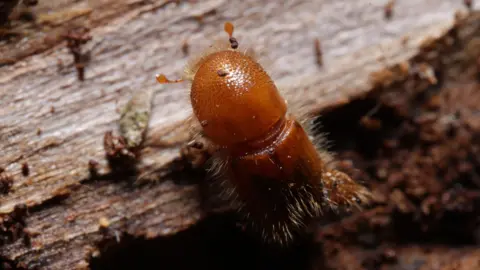 Sean Gallup/Getty Images
Sean Gallup/Getty ImagesIt is smaller than your fingernail, but this hairy beetle is one of the biggest single threats to the UK’s forests.
The bark beetle has been the scourge of Europe, killing millions of spruce trees, yet the government thought it could halt its spread to the UK by checking imported wood products at ports.
But this was not their entry route of choice – they were being carried on winds straight over the English Channel.
Now, UK government scientists have been fighting back, with an unusual arsenal including sniffer dogs, drones and nuclear waste models.
They claim the UK has eradicated the beetle from at risk areas in the east and south east. But climate change could make the job even harder in the future.
The spruce bark beetle, or Ips typographus, has been munching its way through the conifer trees of Europe for decades, leaving behind a trail of destruction.
The beetles rear and feed their young under the bark of spruce trees in complex webs of interweaving tunnels called galleries.
When trees are infested with a few thousand beetles they can cope, using resin to flush the beetles out.
But for a stressed tree its natural defences are reduced and the beetles start to multiply.
“Their populations can build to a point where they can overcome the tree defences – there are millions, billions of beetles,” explained Dr Max Blake, head of tree health at the UK government-funded Forestry Research.
“There are so many the tree cannot deal with them, particularly when it is dry, they don’t have the resin pressure to flush the galleries.”
Since the beetle took hold in Norway over a decade ago it has been able to wipe out 100 million cubic metres of spruce, according to Rothamsted Research.
‘Public enemy number one’
As Sitka spruce is the main tree used for timber in the UK, Dr Blake and his colleagues watched developments on continental Europe with some serious concern.
“We have 725,000 hectares of spruce alone, if this beetle was allowed to get hold of that, the destructive potential means a vast amount of that is at risk,” said Andrea Deol at Forestry Research. “We valued it – and it’s a partial valuation at £2.9bn per year in Great Britain.”
There are more than 1,400 pests and diseases on the government’s plant health risk register, but Ips has been labelled “public enemy number one”.
The number of those diseases has been accelerating, according to Nick Phillips at charity The Woodland Trust.
“Predominantly, the reason for that is global trade, we’re importing wood products, trees for planting, which does sometimes bring ‘hitchhikers’ in terms of pests and disease,” he said.
Forestry Research had been working with border control for years to check such products for Ips, but in 2018 made a shocking discovery in a wood in Kent.
“We found a breeding population that had been there for a few years,” explained Ms Deol.
“Later we started to pick up larger volumes of beetles in [our] traps which seemed to suggest they were arriving by other means. All of the research we have done now has indicated they are being blown over from the continent on the wind,” she added.
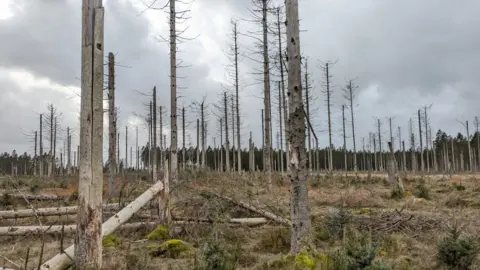 Daegan Inward/Forestry Research
Daegan Inward/Forestry ResearchThe team knew they had to act quickly and has been deploying a mixture of techniques that wouldn’t look out of place in a military operation.
Drones are sent up to survey hundreds of hectares of forest, looking for signs of infestation from the sky – as the beetle takes hold, the upper canopy of the tree cannot be fed nutrients and water, and begins to die off.
But next is the painstaking work of entomologists going on foot to inspect the trees themselves.
“They are looking for a needle in a haystack, sometimes looking for single beetles – to get hold of the pioneer species before they are allowed to establish,” Andrea Deol said.
In a single year her team have inspected 4,500 hectares of spruce on the public estate – just shy of 7,000 football pitches.
Such physically-demanding work is difficult to sustain and the team has been looking for some assistance from the natural and tech world alike.
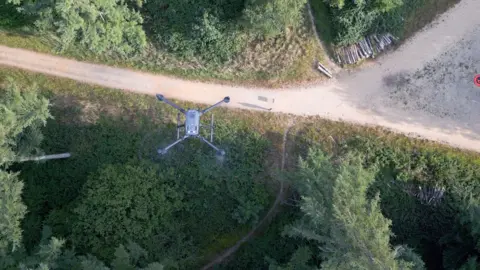 Tony Jolliffe/BBC
Tony Jolliffe/BBCWhen the pioneer Spruce bark beetles find a suitable host tree they release pheromones – chemical signals to attract fellow beetles and establish a colony.
But it is this strong smell, as well as the smell associated with their insect poo – frass – that makes them ideal to be found by sniffer dogs.
Early trials so far have been successful. The dogs are particularly useful for inspecting large timber stacks which can be difficult to inspect visually.
The team is also deploying cameras on their bug traps, which are now able to scan daily for the beetles and identify them in real time.
“We have [created] our own algorithm to identify the insects. We have taken about 20,000 images of Ips, other beetles and debris, which have been formally identified by entomologists, and fed it into the model,” said Dr Blake.
Some of the traps can be in difficult to access areas and previously had only been checked every week by entomologists working on the ground.
The result of this work means that the UK has been confirmed as the first country to have eradicated Ips Typographus in its controlled areas, deemed to be at risk from infestation, and which covers the south east and east England.
“What we are doing is having a positive impact and it is vital that we continue to maintain that effort, if we let our guard down we know we have got those incursion risks year on year,” said Ms Deol.
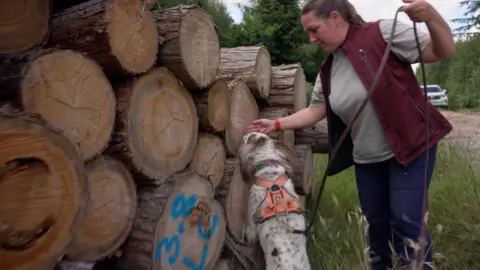 Tony Jolliffe/BBC
Tony Jolliffe/BBCAnd those risks are rising. Europe has seen populations of Ips increase as they take advantage of trees stressed by the changing climate.
Europe is experiencing more extreme rainfall in winter and milder temperatures meaning there is less freezing, leaving the trees in waterlogged conditions.
This coupled with drier summers leaves them stressed and susceptible to falling in stormy weather, and this is when Ips can take hold.
With larger populations in Europe the risk of Ips colonies being carried to the UK goes up.
The team at Forestry Research has been working hard to accurately predict when these incursions may occur.
“We have been doing modelling with colleagues at the University of Cambridge and the Met Office which have adapted a nuclear atmospheric dispersion model to Ips,” explained Dr Blake. “So, [the model] was originally used to look at nuclear fallout and where the winds take it, instead we are using the model to look at how far Ips goes.”
Nick Phillips at The Woodland Trust is strongly supportive of the government’s work but worries about the loss of ancient woodland – the oldest and most biologically-rich areas of forest.
Commercial spruce have long been planted next to such woods, and every time a tree hosting spruce beetle is found, it and neighbouring, sometimes ancient trees, have to be removed.
“We really want the government to maintain as much of the trees as they can, particularly the ones that aren’t affected, and then also when the trees are removed, supporting landowners to take steps to restore what’s there,” he said. “So that they’re given grants, for example, to be able to recover the woodland sites.”
The government has increased funding for woodlands in recent years but this has been focused on planting new trees.
“If we only have funding and support for the first few years of a tree’s life, but not for those woodlands that are 100 or century years old, then we’re not going to be able to deliver nature recovery and capture carbon,” he said.
Additional reporting Miho Tanaka

AI Research
AI replaces excuses for innovation, not jobs
AI isn’t here to replace jobs, it’s here to eliminate outdated practices and empower entrepreneurs to innovate faster and smarter than ever before.

AI Research
AI clamps down on fake science journals
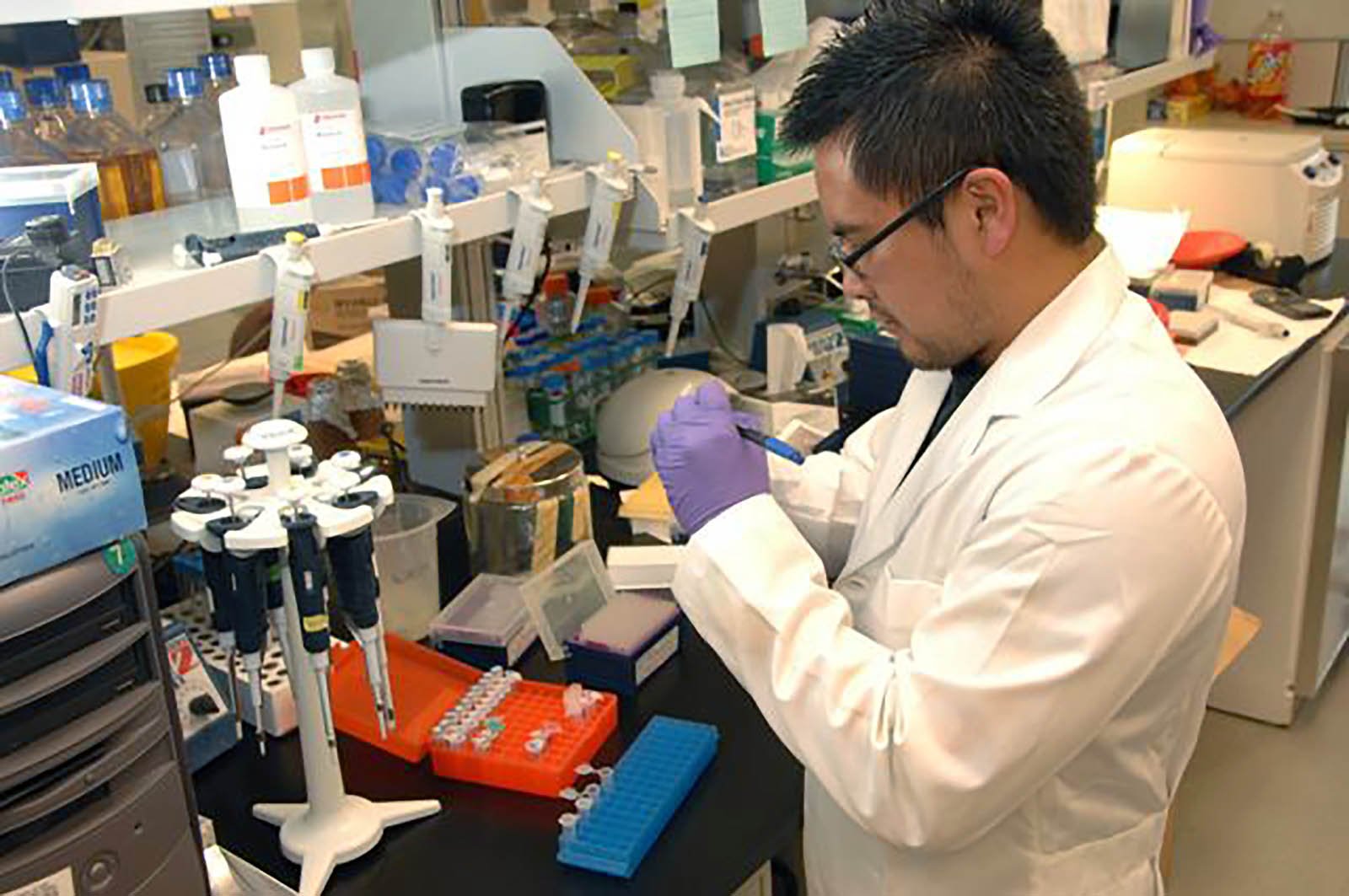
Medical Laboratory Scientist at bench with micropipettes. —
Courtesy U.S. National Institutes of Health (Public Domain)
By deploying a specially configured artificial intelligence, researchers at the University of Colorado Boulder have exposed ‘predatory’ scientific journals—those that trick scientists into paying for publication without proper peer review.
This was achieved by analyzing journal websites for AI-learned red flags like fake editorial boards, excessive self-citation, and sloppy errors. Through these pre-sets. the AI flagged over 1,400 suspicious titles out of 15,200 assessed.
The new AI tool automatically screens scientific journals, evaluating their websites and other online data for certain criteria: Do the journals have an editorial board featuring established researchers? Do their websites contain a lot of grammatical errors?
Many scientists, including this author, receive messages to our email inboxes. These spam messages come from people who purport to be editors at scientific journals, usually ones Acuña has never heard of, and offer to publish his papers — for a hefty fee.
The types of publications are sometimes referred to as “predatory” journals, since they target scientists, convincing them to pay hundreds or even thousands of dollars to publish their research without proper vetting.
Some organisations have long campaigned against such publications. For instance, the Directory of Open Access Journals (DOAJ). Since 2003, volunteers at the DOAJ have flagged thousands of journals as suspicious based on six criteria. (Reputable publications, for example, tend to include a detailed description of their peer review policies on their websites.)
Why does this matter?
In an era when prominent figures (notably Donald Trump) are questioning the legitimacy of science, stopping the spread of questionable publications has become more important than ever before.
Legitimate science
When scientists submit a new study to a reputable publication, that study usually undergoes a practice called peer review. In other words, outside experts read the study and evaluate it for quality.
AI model
The new AI system is not yet publicly accessible; however, the researchers hope to make it available to universities and publishing companies soon.
The application of the AI model appears in the journal Science Advances, titled “Estimating the predictability of questionable open-access journals.”
-
Tools & Platforms3 weeks ago
Building Trust in Military AI Starts with Opening the Black Box – War on the Rocks
-

 Ethics & Policy1 month ago
Ethics & Policy1 month agoSDAIA Supports Saudi Arabia’s Leadership in Shaping Global AI Ethics, Policy, and Research – وكالة الأنباء السعودية
-

 Events & Conferences3 months ago
Events & Conferences3 months agoJourney to 1000 models: Scaling Instagram’s recommendation system
-

 Jobs & Careers2 months ago
Jobs & Careers2 months agoMumbai-based Perplexity Alternative Has 60k+ Users Without Funding
-

 Business1 day ago
Business1 day agoThe Guardian view on Trump and the Fed: independence is no substitute for accountability | Editorial
-

 Funding & Business2 months ago
Funding & Business2 months agoKayak and Expedia race to build AI travel agents that turn social posts into itineraries
-

 Education2 months ago
Education2 months agoVEX Robotics launches AI-powered classroom robotics system
-

 Podcasts & Talks2 months ago
Podcasts & Talks2 months agoHappy 4th of July! 🎆 Made with Veo 3 in Gemini
-

 Podcasts & Talks2 months ago
Podcasts & Talks2 months agoOpenAI 🤝 @teamganassi
-

 Jobs & Careers2 months ago
Jobs & Careers2 months agoAstrophel Aerospace Raises ₹6.84 Crore to Build Reusable Launch Vehicle


